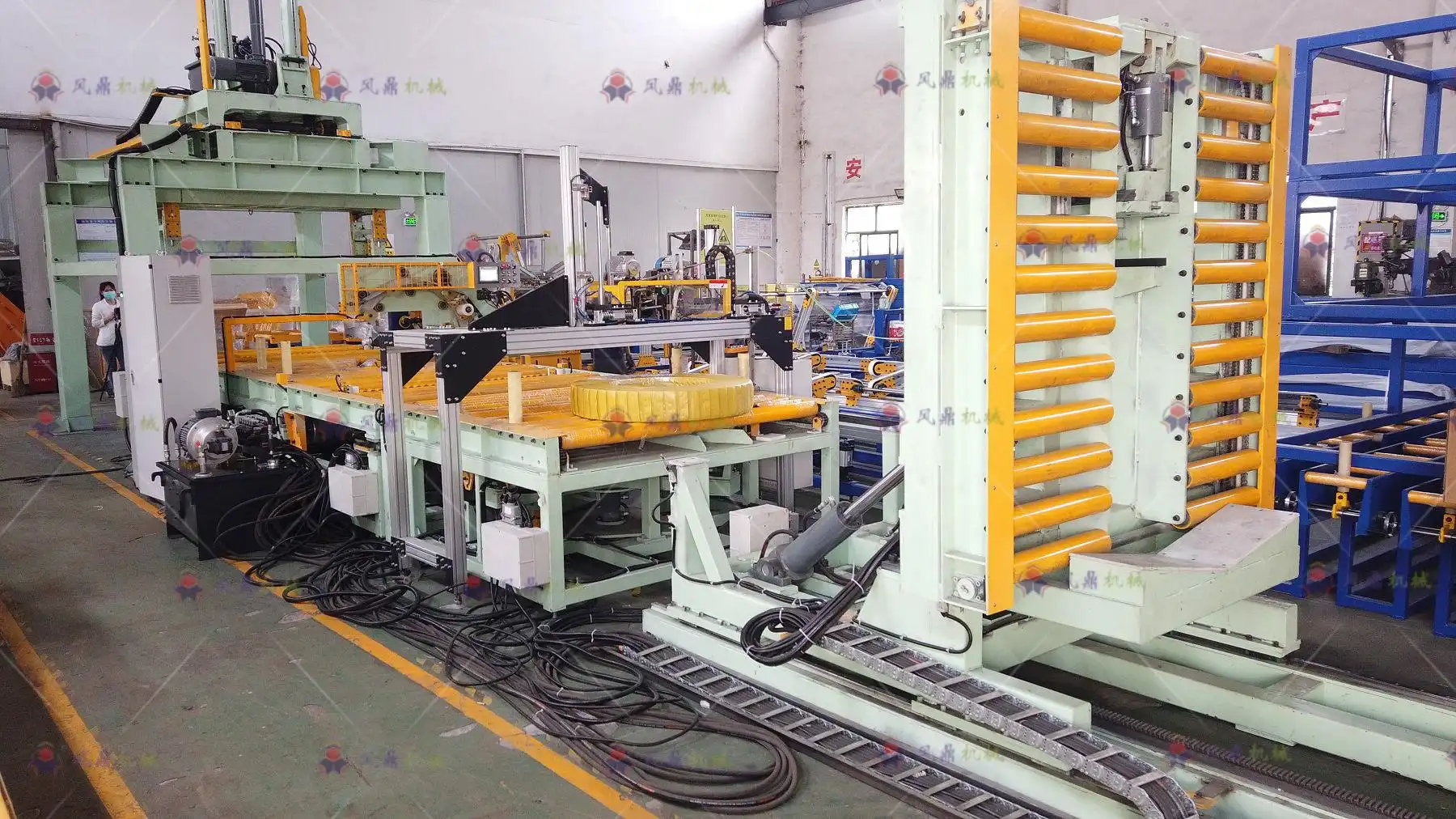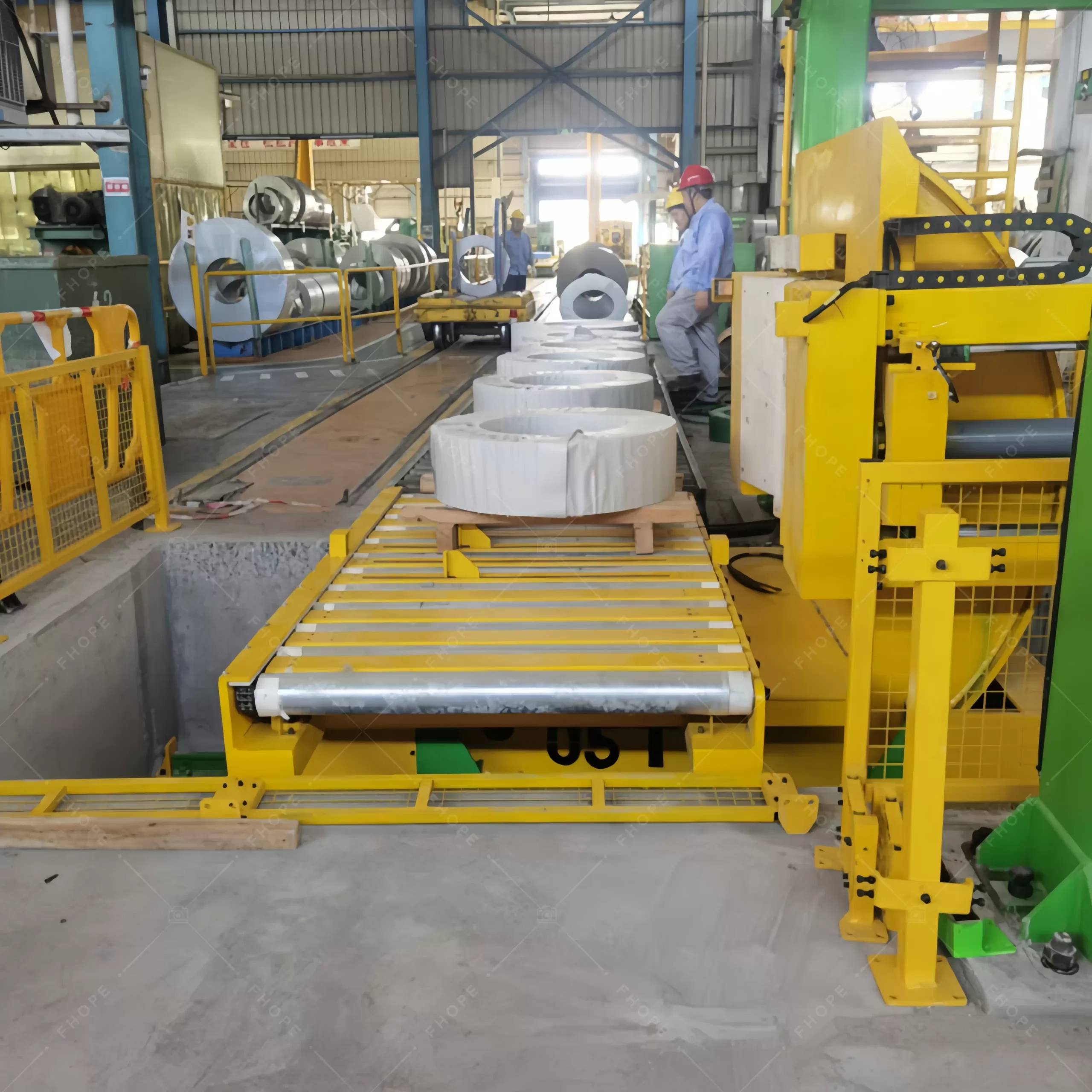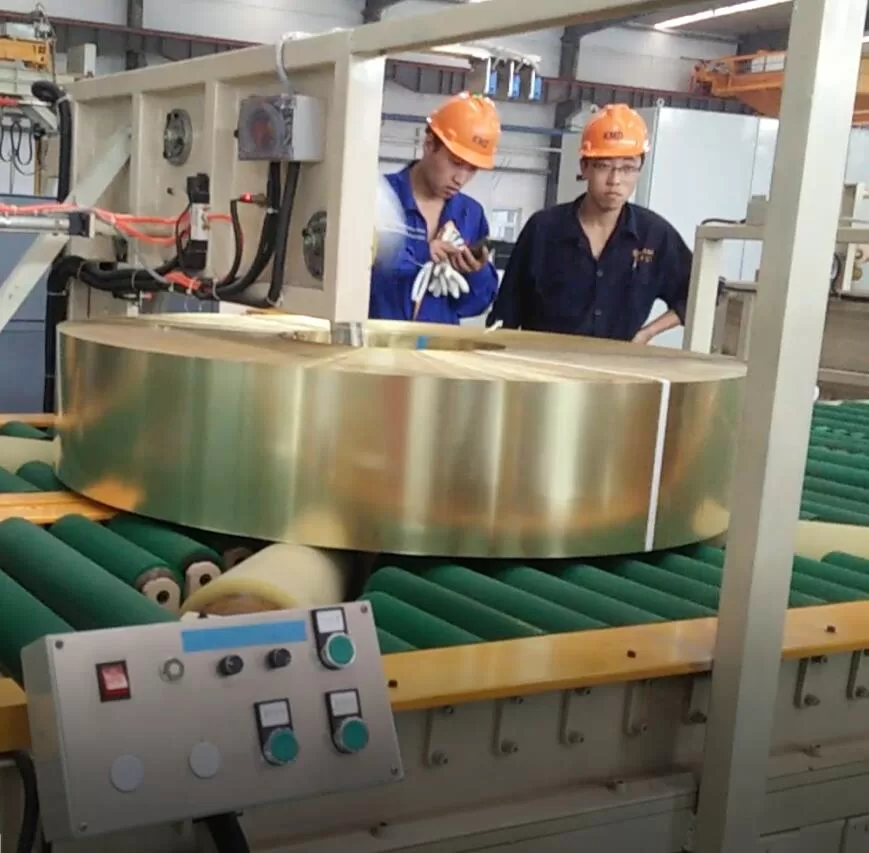Running a steel mill in Saudi Arabia presents a unique set of challenges. I’ve spoken with many mill owners who are feeling the pressure. They need to modernize to keep up with Vision 2030, but their aging equipment is holding them back. An old, inefficient slit coil packing line can quickly become a major bottleneck, causing production delays, safety hazards, and damaging your hard-earned reputation. Every time a coil is packed improperly or the line breaks down, you lose money and risk falling behind competitors who are embracing smarter technology. It’s a frustrating position to be in, especially when the harsh, dusty environment wears down your machinery even faster. But choosing a new packing line is more than just an equipment upgrade. It's a strategic move that can define your mill's future. By focusing on the right features, you can turn your packing area from a liability into a powerful asset that drives efficiency and profit.
For a slit coil packing line in a Saudi steel mill, the most critical features are robust automation for high-speed operation, durable construction designed for hot and dusty climates, seamless data integration with existing MES/ERP systems, and advanced safety mechanisms to protect personnel and products. These elements work together to create a reliable, efficient, and future-proof system that delivers a strong return on investment in the demanding Saudi industrial landscape.

I know that a list of features is just the beginning. The real key to making a smart investment is understanding why these features matter and how they directly address the pains you feel every day on the factory floor. In my journey from being an engineer to owning my own packing machine factory, I’ve seen firsthand what separates a good machine from a great one. Let's break down each of these critical areas. I want to share my experience to help you see how the right technology can transform your operations.
How Can Automation in Packing Lines Combat Rising Labor Costs and Improve Safety?
Finding skilled and reliable workers for the packing line is getting harder and more expensive every year. This is a problem I hear about from clients all over the world, including in Saudi Arabia. The work is repetitive, physically demanding, and happens right next to heavy, moving equipment. It’s a tough job to fill. When you rely on manual packing, you're not just dealing with high labor costs. You're also facing inconsistency, slower production speeds, and a constant risk of accidents. A single mistake can lead to a damaged coil, or far worse, an injured employee. This is a heavy burden for any plant manager or owner to carry. The solution is to let machines do what they do best. A fully automated packing line takes over the dangerous and repetitive tasks, creating a safer and more efficient environment while allowing you to move your skilled people into roles where they can add more value.
Automation combats labor costs by reducing the need for manual operators in repetitive tasks and improves safety by minimizing human interaction with heavy coils and moving machinery. Key automated features include automatic coil loading, strapping, wrapping, labeling, and palletizing, which create a consistent, high-speed, and secure workflow. This technology works tirelessly, 24/7, without compromising on quality or safety.

From Manual to Autonomous: A Step-by-Step Evolution
When I first started in this industry, many packing lines were semi-automatic at best. An operator would still need to feed the strapping, position the coil, and manually start each cycle. It was an improvement over pure manual labor, but it was still slow and heavily dependent on the operator's skill and attention. Today, we can design a line that is almost completely "hands-off." The process starts the moment a slit coil leaves the recoiler. An automated tilter receives the coil and places it on a conveyor. From there, it moves through each station without human intervention. The coil is automatically measured, strapped, wrapped with protective film, and then a label with a barcode and all production data is printed and applied. Finally, an automated system can stack the coils onto a pallet, ready for shipping. This isn't science fiction; this is the technology that leading mills are using right now.
The Real ROI of Automation
The return on investment (ROI) for automation goes far beyond just reducing payroll. Think about consistency. An automated wrapper applies the exact same amount of film with the same tension every single time. An automated strapper places straps in the precise locations needed for maximum stability. This level of precision is impossible to achieve with manual labor over a long shift. This consistency means fewer damaged products during transit, which means fewer customer complaints and claims. It also means you use exactly the amount of packing material you need, eliminating waste. Safety is another huge part of the ROI. By removing people from the immediate packing area, you drastically reduce the risk of accidents. The cost of a single serious injury—in terms of medical bills, lost production, and legal issues—can easily exceed the cost of an automated system.
| Metric | Manual Packing | Fully Automated Packing |
|---|---|---|
| Speed (Coils/Hour) | 5-10 | 30-60+ |
| Consistency | Low (Varies by operator) | High (Identical every time) |
| Material Waste | 10-15% | <2% |
| Safety Risk | High | Very Low |
| Labor Requirement | 3-4 Operators per shift | 1 Supervisor per line |
| Data Accuracy | Prone to human error | 99.9%+ (scanned) |
What Role Does Data Integration (IoT & MES) Play in Modernizing a Saudi Packing Line?
You can't manage what you can't measure. In many steel mills, the packing line is an information black hole. You have detailed data from your furnace and your slitter, but once the coil hits the packing area, that visibility disappears. You don't know exactly when a specific coil was packed, how long it took, or if there were any issues during the process. This lack of data is a major problem. It makes it nearly impossible to trace quality issues back to their source. It leads to shipping errors and inventory discrepancies. You are essentially flying blind at the last, critical step before your product reaches the customer. It's a frustrating gap in an otherwise data-driven operation. The solution is to integrate your packing line into your factory’s digital network. By using IoT sensors and connecting the line to your Manufacturing Execution System (MES), you gain complete, real-time visibility and control over the entire packing process.
Data integration via IoT and MES transforms a packing line from a standalone unit into an intelligent node within the factory's ecosystem. It enables real-time tracking of each coil, automatic data logging for quality control, predictive maintenance alerts, and seamless communication with your ERP system for accurate inventory management and shipping. This turns your packing data into a powerful tool for optimization.

Beyond Packing: Creating a Digital Footprint
A modern packing line does more than just wrap steel. It creates a digital record for every single coil. Here’s how it works at SHJLPACK. When a coil arrives at the packing line, its ID is scanned from the slitter's production order. This ID is now linked to everything that happens next. The system records the time it was packed, the weight, the dimensions, the number of straps applied, and the type of wrapping material used. All of this data is sent directly to your MES. If a customer calls three months later with an issue, you can pull up the complete history of that coil in seconds. You can see who the operator was, what machine settings were used, and even review sensor data from the wrapping process. This level of traceability is essential for quality control and for meeting the strict requirements of industries like automotive and construction.
Key Integration Points for Maximum Impact
True integration isn't just about having an Ethernet port on the control panel. It’s about a thoughtful connection between the physical machine and your software systems. We focus on providing actionable data. For instance, we install sensors that monitor the motor current on the wrapping ring. If the current starts to trend upward over several weeks, it's a clear sign that a bearing might be failing. The system can automatically send a maintenance alert to your team long before the machine actually breaks down. This is predictive maintenance, and it saves you from costly unplanned downtime. We also ensure the packing line can receive information from your MES. For example, your system can tell the packing line what kind of packaging a specific customer requires, and the machine will automatically adjust its program. This eliminates human error and ensures every order is packed to the correct specification.
| Feature / Technology | Data Provided | Business Benefit |
|---|---|---|
| Barcode/RFID Scanner | Coil ID, Customer Order | Real-time tracking, error-proof processing. |
| Integrated Weigh Scale | Exact coil weight | Accurate shipping documents, inventory control. |
| Motor Current Sensors | Power consumption, performance | Predictive maintenance alerts, energy monitoring. |
| Cycle Time Counter | Time per coil, station delays | Bottleneck analysis, OEE calculation. |
| MES/ERP Connection | All of the above | Full production visibility, data-driven decisions. |
Why is Durability and Low Maintenance a Non-Negotiable for Saudi Environments?
Let's be direct. A standard packing machine will not survive for long in a Saudi steel mill. I've seen it happen. The combination of extreme ambient heat, which can exceed 50°C, and the constant presence of fine, abrasive metal dust creates an incredibly hostile environment for machinery. The heat causes electronics to overheat and fail. The dust gets into bearings, chains, and electrical cabinets, causing premature wear and short circuits. It's a recipe for disaster. This leads to constant breakdowns, frequent production stops, and a maintenance team that is always putting out fires. You end up spending far too much time and money just trying to keep the line running, which kills your productivity and your profits. For this reason, you cannot treat durability as just another feature. It must be the foundation of the entire machine's design. Investing in a machine built specifically to withstand these harsh conditions is the only way to ensure reliability and protect your investment.
Durability and low maintenance are non-negotiable in Saudi environments because the combination of high ambient temperatures, airborne dust, and corrosive particles can rapidly degrade standard machinery. Features like sealed bearings, IP65-rated electronics enclosures, heavy-duty structural frames, and corrosion-resistant coatings are essential to prevent frequent breakdowns and ensure consistent uptime.

Designing for Dust and Heat
When we design a machine for a client in the Middle East, our engineering approach is different from the start. We don't just put a standard machine in a bigger box. We build it for the environment. This means using heavy-gauge steel for the frame, much thicker than the industry standard, to resist vibration and fatigue. All electrical cabinets are NEMA 4X or IP65 rated, which means they are completely sealed against dust and can withstand water. We also install industrial air conditioners on these cabinets to keep the PLCs, drives, and other sensitive electronics cool and stable, even when the temperature in the mill is soaring. For mechanical components, we use sealed-for-life bearings wherever possible to keep dust out. Chains are often replaced with high-quality, low-maintenance belts. We think about every detail, right down to the type of paint, using special epoxy coatings that resist chipping and corrosion.
The Hidden Costs of Poor Construction
A few years ago, a potential client asked me why our machine was priced higher than a competitor's. I flew to his mill to see the machine he was considering. On the surface, it looked fine. But when I looked closer, I saw the problems. The frame was made of thin steel. The electrical cabinet had simple vents with a cheap filter that would clog with dust in days. The bearings were open and exposed. I explained to him that while he might save money on the purchase price, he would pay for it over and over again in downtime and spare parts. A machine like that might last a year or two before it started having major problems. A well-built machine is designed to last for 15-20 years with only routine maintenance. The true cost of a machine isn't what you pay for it; it's what it costs you to own it over its entire lifespan.
| Environmental Challenge | Standard Design (Failure Point) | SHJLPACK Robust Design (Solution) |
|---|---|---|
| High Ambient Heat | Vented electrical cabinets | Air-conditioned, IP65-sealed cabinets. |
| Abrasive Dust | Open bearings, exposed chains | Sealed-for-life bearings, enclosed mechanisms. |
| 24/7 Operation | Light-duty frame and motors | Heavy-gauge steel frame, oversized motors. |
| Corrosive Air | Standard paint | Multi-layer epoxy or powder coating. |
| Vibrations | Bolted connections | Welded frame, high-tensile bolts. |
How Does a Modular Packing Line Design Future-Proof Your Investment?
The steel market is not static. It changes. Your customers' needs change. The types of coils you produce might be different in five years. You might need to increase your throughput or comply with new packaging standards. This is a major concern for any CEO or owner making a significant capital investment. If you buy a rigid, one-size-fits-all packing line, you are locking yourself into today's requirements. This is a huge risk. When your business needs to adapt, a monolithic machine can't change with you. You are then faced with the massive expense and disruption of replacing the entire line. Your initial investment quickly becomes obsolete. A much smarter approach is to invest in a modular design. This gives you the flexibility to adapt, upgrade, and reconfigure your line as your business evolves, ensuring it remains a valuable asset for many years to come.
A modular packing line future-proofs your investment by allowing you to easily add, remove, or upgrade individual components (modules) without replacing the entire system. This means you can adapt to new coil sizes, different packing materials, or increased throughput demands incrementally and cost-effectively as your business grows. It's like building with LEGOs instead of carving from a single block of stone.

The Building Blocks of a Flexible Line
Think of a modular line as a series of independent stations connected by a central conveyor and control system. Each station performs one specific task: a tilting module, a strapping module, a wrapping module, a labeling module. At SHJLPACK, we design each of these modules to be self-contained. They have their own controls that communicate with the main line controller, but they can be physically and digitally "unplugged" and replaced. For example, let's say you start by shipping coils with simple stretch film. Two years later, a major new customer requires VCI paper wrapping for better corrosion protection. With a modular line, you don't need to scrap everything. We can build a new VCI paper wrapping module, ship it to your facility, and swap it with the old stretch film module over a weekend. The rest of your line remains untouched.
Scalability: Growing with Your Mill
Modularity is also the key to scalability. Perhaps your mill is currently producing at 70% capacity, but you have plans to expand. You can purchase a packing line that meets your current needs, but design it with empty space for future modules. For example, you might start with one strapping machine. As your production increases and the strapping station becomes a bottleneck, you can simply add a second strapping module in parallel. The control system is already designed to manage this expansion. This "pay as you grow" approach is much more capital-efficient than buying a massive, oversized line from day one that sits underutilized for years. It allows you to align your capital expenditures directly with your revenue growth. This strategic flexibility is something I always emphasize to my clients. It turns a machine purchase into a long-term, adaptable partnership.
| Future Business Need | Rigid Line Solution | Modular Line Solution |
|---|---|---|
| Increase Throughput | Replace entire line. | Add a second wrapping/strapping module. |
| New Packaging Material | Major, costly rebuild. | Swap out the existing wrapping module. |
| Different Coil Sizes | Often impossible. | Adjust/replace conveyor guides and grippers. |
| Add Automation Step | Very difficult to integrate. | Add a new module (e.g., automated palletizer). |
| Budget Constraints | Must buy full system. | Start with essential modules, add more later. |
Conclusion
Choosing the right slit coil packing line is about balancing automation, durability, data, and flexibility. This strategic approach ensures long-term ROI for Saudi steel mills.





